ARCADIA! The word suggest images of pastoral bliss and goat-legged Pan, the god of shepherds, twirling around olive trees, playing his pan-pipes. It was a place that inspired the European poets and painters of the 18th and 19th centuries and suggested an innocent, golden age. It sometimes seems more of a mythical place than a real province. So, on a cool autumn day, we set off from the tip of the Messinian peninsula and drove north to discover what Arcadia is all about, and if it still has mythical charm. The excellent Cadogen guidebook, Peloponnese and Athens, describes Arcadia as “one of the best kept secrets of the Peloponnese … a place that seemed ancient even in ancient times”. I know just what that means now as Arcadia has a certain timelessness, sitting snug amid mountains and ravines in the centre of the Peloponnese.
We were heading for the mountain eyrie of Stemnitsa, west of Tripolis. It is one of several mountain outposts in this region, including Dimitsana and Karitaina, but Stemnitsa is also claimed to be one of the 15 most beautiful villages in Greece. Dating back to the Middle Ages, Stemnitsa is built in giddy tiers up a precipice on the western slopes of Mount Menalo, at 1,100 metres, with a view down the long, deep Lousios Gorge.
On the day of our visit it had a wintry feel so high up, despite being a warm day elsewhere. The main square is the heart of this old village, with tables and chairs under the walnut and cherry trees, an old church nearby, and a few tavernas and kafeneia. The Gerousia is an elegant old kafeneio with outdoor seating, but it wasn’t hard to imagine how, in deep winter, villagers would be huddled around the central wood-burning stove inside. It has a feel of how kafeneia used to be in Greece, and in case you can’t imagine it, there is a wonderful collection of old photos around the walls showing groups of villagers from last century sitting outside the main door. Sophia, the owner’s mother, is very friendly and obviously proud of the establishment, as it featured not long ago in a travel story in a popular Greek magazine. Along with coffee she serves some of the local sweets like skaltsounia, pastry shells filled with walnuts and honey. She was very taken with our Jack Russell dog Wallace hiding under the table. “He’s very quiet,” she said. I knew she was tempting fate and the minute her back was turned he sprang to life, like Pan chasing a woodland nymph and barked loudly, scattering a group of passers-by. Just another day in Arcadia! Before we left, Sophia gave us a small container of cherry tomatoes from her garden to take away, and insisted we try a couple first. They were sweet and delicious and it was a nice gesture of hospitality. But coffee followed by tomatoes? Don’t try it at home!
The village is full of old-world charm with some quirky rural corners – great stacks of olive wood for the winter, donkeys tethered in gardens, gates and fences seemingly fashioned by crafty elves from sticks. It could have been a setting for a Brothers Grimm fairytale, without all the scary stuff. The village is best appreciated by walking up the narrow streets bordered by solid stone houses with heavy wooden shutters built for winter weather.
The village is also renowned for its gold and silver smithery and there is school here in an old renovated building that teaches the craft. Several shops selling items made there and also a range of other traditional and modern jewellery, and at least one with more folky designs called the Politimes Dimiourgies.
There are 18 churches here, from the 12th century to 17th century, though you will need to ask around or the keyholders. The church in the main square, Ayios Yiorgos, is open most mornings and has a nice collection of frescos and an intriguing relic in a silver box which is a piece of bone from the 13-century Peloponnesian saint Leontios. Most of the village is open in the winter and has some nice boutique hotels.
One of the more curious attractions of this area are the three amazing monasteries built along the side of the Lousios Gorge, particularly the monastery of the Timios Prodromou. You can’t see the monastery from its parking area at the top of the gorge and a sign sends you on to a cobbled path that leads down the side of the gorge. Just when you think it can’t possibly be here, because there’s nothing but a steep-sided ravine, and trees, you look up and there it is, above you, a long mass of buildings clinging like limpets to the rockface, with some tiny, box-like structures with wooden buttresses underneath. It’s eerily quiet in the afternoon, hours before the monastery opens for visitors, and all you can hear are the sounds of birds and the Lousios river gushing way below, and maybe even Pan pipes when the vibes are right.
The Prodromou monastery was established in the 12th century and its church is also built into the rockface, with frescos from the 16th century. It hasn’t always been as quiet though. This area was the haunt of hero and clan chief Theodoros Kolokotronis, who was one of the leaders of the Messinian uprising against the Ottoman Turks that kicked off the War of Independence in 1821. During the war, he took refuge in this area and in the Promdromou church, securely locked by an impenetrable thick wooden door which was repeatedly shot at by the invading Turks and still bears the bullet holes to this day (see photo above).
A trip to this region wouldn’t be complete without a visit to the site of Ancient Gortys, further down the gorge from Stemnitsa. The site was established in 335 BC and was once an important shrine and centre of healing. In the river Lousios below, Zeus, the father of the Gods, was said to have been bathed as a child. Alexander the Great was so impressed with the site he offered his breast plate and shield as a tribute.
There’s not much to see here now apart from fallen columns and crumbling walls amid ancient olive trees and clumps of wild sage. The original ‘spa’ and bathing area is still visible, with a curious wall of ‘cublicles’, each with a small stone depression in front, which may have been for foot bathing, and I can only assume the ancient Gortyians had tiny feet.
Arcadia is an enchanting place that does feel rather ancient, a small corner of Greece that probably won’t change much because of its mountainous terrain. Perhaps the minxy nymphs and sprites that inhabit this blissful zone had taken control of our sense of direction but when we left late in the afternoon, with a long drive back to Koroni, we ended up driving west past the equally alluring town of Karitaina, with its massive castle atop a craggy hill, instead of heading south, and added another hour on to our journey. For more information about Arcadia and what to see, visit the Greek government website www.mythicalpeloponnese.gr
He ain’t heavy, he’s a Jack Russell!
AFTER my book about living in the Peloponnese, Things Can Only Get Feta (Bene Factum Publishing), came out last year, a few readers contacted me about one of the chapters. They doubted that you could get a Jack Russell terrier to sit still in a rucksack. Readers might recall that we smuggled Wallace into an archaeological site near Kalamata after being told dogs were not allowed in. So, here’s a picture that shows it’s possible. But how did we keep him quiet for a while once he was inside? Well, you’ll just have to read the book … For details about the book and where to buy it and its sequel, Homer’s Where the Heart Is, Big Fat Greek Odyssey website, book page.
Visit Amazon to buy the book (Kindle version – new edition). A new edition is also available. Please remember that reviews on Amazon are always much appreciated, however small they are. Thanks for stopping by and your comments on the blog are always welcome too.
© All rights reserved. Text and photographs copyright of the authors 2016. No content/text or photographs may be copied from the blog or used in any way without the prior written permission of the authors. This applies to all posts on the blog.
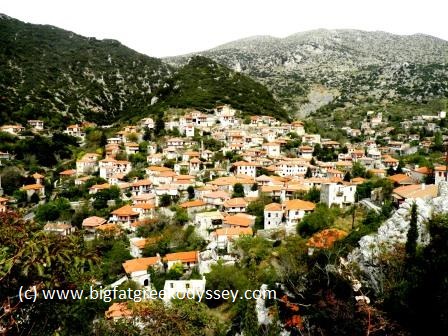
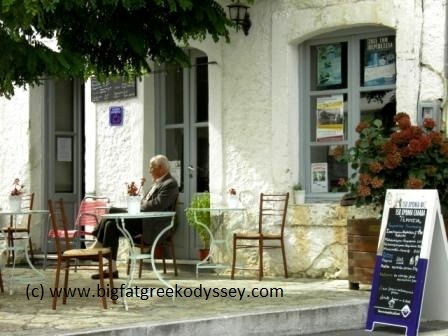
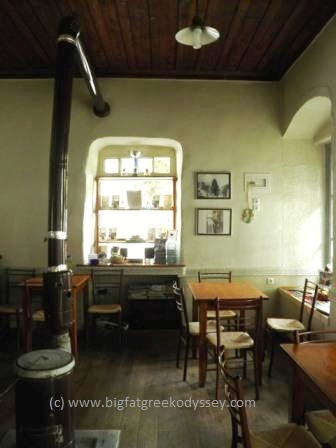
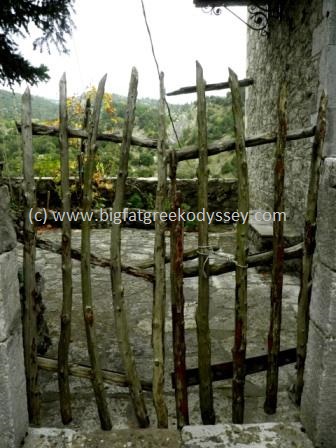
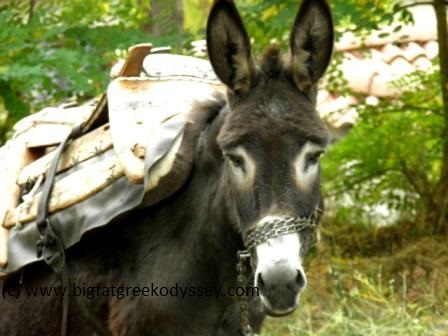


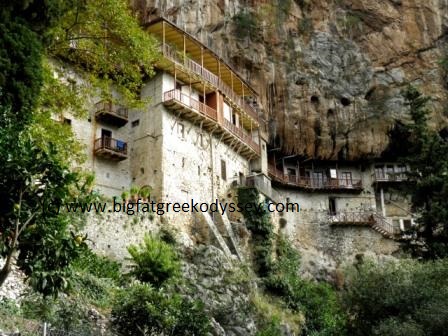

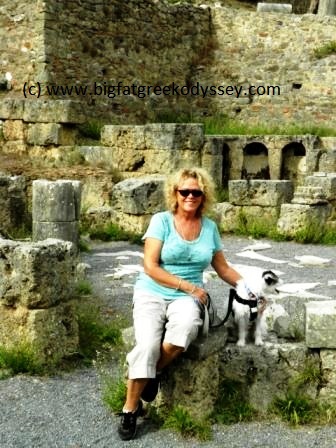
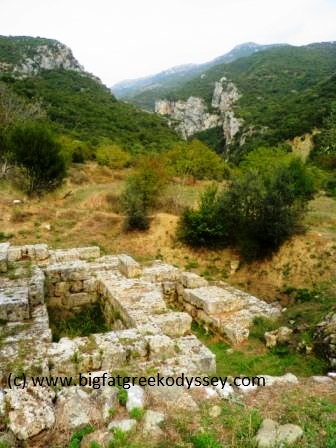
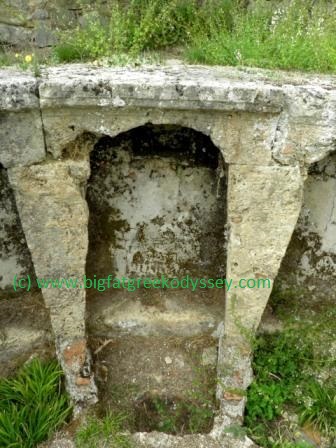


What an amazing job you did, Marjory, describing that beautiful village! Not even a native could do it better. We love Stemnitsa! We have many friends there and always visit for food of coffee and…
I write in my book about Arcadia and Dimitsana and my love and connection to that place. I can’t wait to read your book.
Wishing you amazing journeys of beauty, wonder, and great knowledge!!!
Hi Katina,
Thanks for your comment. I didn’t get to Dimitsana on that trip but next time hopefully. It’s such an enchanting area and needs a bit more time to explore. How wonderful for you to have a connection to Arcadia. That makes you enchanting as well!
I look forward to reading your book one day soon.
Kind regards,
Marjory x
Thank you for ascribing enchantment to me by way of roots! 🙂
Best regards too, Katina!
Oh why had I not seen your blog before now?
How wonderful to read about Greece through the eyes of another
“foreigner” little details are noticed that locals may take for granted.
A lovely read Marjory, thank you,.
I shall be an avid follower from now on.
Love little Wallace in the back pack!
Have a great weekend,
Susan.x
Hi Susan,
Thank you for your comment and enthusiasm about the blog. It’s very much appreciated. I hope you will enjoy future blogs as well. Do keep in touch.
Regards,
Marjory
Fresh and beautiful, every time I read this post.
Thanks for reminding me, Marjory, to delve into this beautiful Arcadian area.
Truly, an enchanting place, since ancient times, but it takes one with soul to see it.
Best Regards,
Katina
xxx
Marjory ,hello from Sunny Sydney .We have a Monastery in Peloponnesus named ‘ Ambelaki ‘ I cannot believe how in the name of ‘ heaven ‘ it was built .Visited many years ago and your blog has bought it all back to me .
loved it , I forgot to add ….👏👏🇬🇷🇬🇷
Real nice post
Informative… charming….
Arcadia is one of the best place to discover…. as a mythical place 🙂
Hi Maria,
Thanks for your comment. I think most tourists still think of the myths of Arcadia and forget it’s also a real region with wonderful villages to explore.
Regards,
Marjory
Hi James,
Thanks so much for your reply.
Regards,
Marjory
Hi Katina,
Thanks for your kind comments. I have only been once to this region but plan to go again and explore more of the villages. Everyone loves the Greek islands, of course, but few tourists ever get to these lovely mountain regions and often don’t realise the authenticity and charm of them.
Regards,
Marjory
Greece is so diverse. Behind every mountain, a new world unfolds.
I love the sea and all the islands and other places up to Macedonia I have visited. The way, though, I feel in my Arcadia has no equal. And it’s not just the diversity in natural flora or the proud mountains themselves but the spirits of all those who lived there that summon me back, inspire me with their strength, and make me the person I should be.
O, Marjory, I am so happy you love my land!!!
xxx
Hi Katina,
Arcadia is not hard to love. And I think you are due a trip back there some time very soon. I think you will find the crisis hasn’t changed it. The charm is not subject to fiscal fluctuations, thank goodness.
Φιλάκια πολλά,
Marjory xxx
Hello Marjory,
I have just found your blog about Stremnitsa, Arcadia. What a charming and fascinating visit. I wish I could get there one day. My bucket list is getting deeper! Would love to know more about the myths and history of it. Sounds wonderful and spiritually inspiring. Did you ever go back there? By the way love the Five for Friday blog (21/5/2019).
I hope your next book will be published soon.
Regards
Pam Fiddimore
Hi Pam,
Thanks for your comment about Arcadia. We haven’t been back since we first visited. To be honest, there’s so much to see in Greece and just in Arcadia alone, a lot of lovely villages. We recently went to the Pelion region and found the mountain villages there were very similar to Arcadia’s. We loved Makrinitsa and Milies.
I am currently writing another novel set in the Mani again but no publishing date yet. I will keep you all posted though. Thanks very much for your interest in my books and blogs.
Kind regards,
Marjory